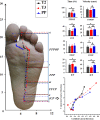Alterations of Pregnant Gait during Pregnancy and Post-Partum
- PMID: 29396468
- PMCID: PMC5797072
- DOI: 10.1038/s41598-018-20648-y
Alterations of Pregnant Gait during Pregnancy and Post-Partum
Abstract
Physique changes during pregnancy lead to gait characteristic variations. This study aimed to analyse gait of pregnant individuals throughout pregnancy and post-partum. Sixteen healthy pregnant women volunteered as participants and had their lower limb kinematics analysed through a VICON three-dimensional motion system and plantar pressure measured with a Novel EMED force plate. Significant changes were observed in pelvic anterior motion, hip and ankle joint kinematics. Mean pressure distribution and COP trajectory deviation altered accordingly with increased pregnancy time, compared with post-partum. This longitudinal study of pregnant gait biomechanics in T2, T3 and PP reveals lower extremity kinematic and foot pressure alterations to adapt to pregnancy related changes, and the COP trajectory highlights a falling risk during pregnancy, particularly in T3.
Conflict of interest statement
The authors declare that they have no competing interests.
Figures




References
-
- Mitternacht J, Klement A, Lampe R. Plantar pressure distribution during and after pregnancy. Eur. Orthop. Traumatol. 2013;4:229–236. doi: 10.1007/s12570-013-0173-7. - DOI
Publication types
MeSH terms
LinkOut - more resources
Full Text Sources
Other Literature Sources
Medical
Miscellaneous

